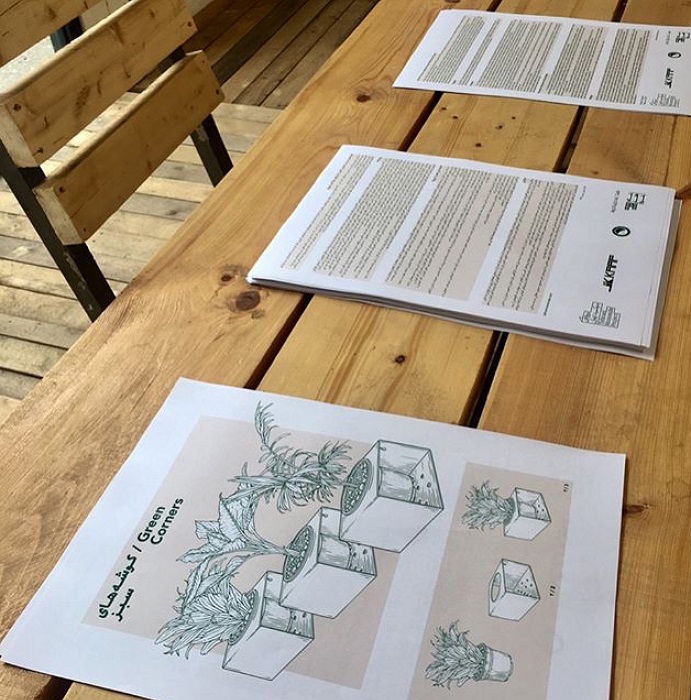
Green Corners
Green Corners in schools by Tehran Monoxide Project
Tehran Monoxide is a cultural and artistic project which has been going on since 2011, in the form of independent projects, in collaboration with artists and citizens from Tehran in public spaces.
This project’s goal is to raise awareness of and offer practical solutions to the problem of air pollution in Tehran. It reflects the viewpoints of people from all walks of life, from children to adults in terms of the issue of air pollution, what they cannot see but do breathe.
Green Corners is fifth phase of Tehran Monoxide Project. The project aims at educating pupils aged from 5 to 18 about caring and maintaining indoor plants. Our reason for doing Green Corners project in schools is lack of interest in plants, these important symbols of life, in the lives of the new generations. In order to address this issue, we had to take a look at the educational system and school books. A brief investigation reveals that little importance is given to plants and green spaces in education while schools are indeed a good starting point for emphasizing the importance of these. Educating our pupils about the basics of caring for indoor plants can lead to more attention to plants and trees.
Subject:
since 2011, Tehran Monoxide has run four projects in public spaces, focusing on two aspects. First, children and adolescents in Tehran, who contribute the least to the city’s air pollution and are harmed the most by it. The second aspect is t highlighting the importance of plants and green spaces as the lungs of the city, and offering solutions and recommendations to the problem.
Projects:
1. On Children’s Day in 2011, this project, in which 36 artists participated, took place at Kherad School in Tehran. The fact that the artists who were invited to collaborate with project had children meant that they were struggling with air pollution and how it affected their children from day to day. The audience was pupils, their families and those citizens who were involved with education on a daily basis.
2. The second project depicted the city from the point of view of children and adolescents, who took photos of Tehran to show how they saw the problem of air pollution and what they thought it stemmed from. In the years 2013 and 2014, these photos were collected from 22 different districts in Tehran and were exhibited at two stages. The first exhibition was held in 2013 with collaboration of Ms. Shadi Ghadirian and Ms. Mahboubeh Karamli, under the supervision of Ms. Sadeghi at Kherad School. Three children from different age groups were awarded and in 2016, some of the photos were exhibited at Warsaw’s Centre for Contemporary Arts.
3. The third project was a photo exhibition by 11 photographers, which was held in a pharmacy in central Tehran. With the collaboration of the participating photographers and the owner of the pharmacy, 20 photos with the subject of children in the city were selected and printed in batches of 250. There were 5000 photos exhibited in different corners of the pharmacy and the customers could choose the ones they liked to take with them.
4. In March 2015, Tehran Monoxide held a popular exhibition introducing indoor plants that help improve the air quality at Negarestan Garden’s greenhouse and sidewalk in Enqelab street.
In 2015, Warsaw’s Centre for Contemporary Arts invited Tehran Monoxide to exhibit the first two projects in an exhibition titled Dust, which was open to the public for two months. Also ZKU
In addition, Tehran Monoxide gave away 110 pot plants to the special guests and participants of “The City’s Breaths Festival” , the first poster and photography festival about air pollution in Tehran. Each pot plant came with a brochure introducing the project, the reason for introducing such plants and plant care tips.

The aims of this part of the project:
•Creating green spaces as a beautiful and effective element to not only turn educational environments into more charming places but also familiarizing students with plants that promote air quality, absorb chemicals and aerosol and transpire.
•Forming teams of people from different fields such as art, physics, chemistry, biology, statistics and math, agriculture …who can collaborate in this project. These people can play a role in improving the school conditions as well as achieve results that will benefit both pupils and the school staff. Such activities lead to creating a sense of accountability which will in turn contribute to a cultural and artistic exchange between pupils and the staff.
•Instilling a sense of responsibility and collaboration in pupils to take care of plants and the green spaces.
•Teaching pupils how to take care of indoor plants step by step. They will start with caring for low-maintenance plants and if they succeed, they will receive a certificate and move onto the next level where they will be given new plants to take care of.
Indoor plants are divided into easy, medium and difficult depending on how long-lasting they are and how sensitive they are to environmental tensions. Easy plants consist of pothos, scandens , sansevieria and zamiifolia, medium plants consist of chamaedorea, dracaena and aglaia, and difficult plants include African violets and peace lily.
Each class will be started off with a pothos and step by step more difficult plants will be added to the green corner.
Design:
planters are designed to meet the specific space requirements of each class as well as the education, collaboration and safety of pupils. Planters are designed to be modular so they can be easily hung on walls and put in any space and secondly allow for growing them from one pot plant to 10 pot plants. The planters are specially designed to record plant care tips as well as the educational activities between teachers and pupils.
The project will create green spaces in schools; therefore, after getting the approval of the school director, we will hold information sessions with pupils who are interested in collaborating with the project. Each period will take 3 months.
Throughout the 3-month period, volunteer pupils will take photos, film, and make a written record of the plants, based on which a digital or actual booklet will be published. There will also be an Instagram page dedicated to the photos, written records, experiences, and educational videos about the Green Corners project.
This project can be presented at galleries, conferences and cultural activities, and be written about in magazines and newspapers.
Special thanks to Kaaf Institute, Alghadir school,,Farhang Sadat school, Manzoumeh Kherad Institute,Mercedeh Sadeghi , Pantea Eslami, Homa Delvaray, Shahrouz Hakimi, Mohammadreza Pourseiedi, Ali Samadpour, Alireza Labeshka, Simin Dehghani, Dr Bemanian, Mahboubeh Maddah, Ghazal Hemati, Abnous Alborzi.
Negar Faragiani
February 2017
گوشههای سبز در مدارس کاری از پروژه منوکسید تهران
+منوکسید تهران پروژهای است هنری و فرهنگی که از سال ۱۳۹۰ فعالیت خود را در قالب پروژههای مستقل و با مشارکت هنرمندان و شهروندان در فضا عمومی آغاز کرده است. گوشههای سبز پروژهی پنجم منوکسید تهران است.
گوشههای سبز آموزش نگهداری و پرورش گیاهان آپارتمانی برای فضاهای داخلی با همکاری دانشآموزان در سه گروه سنی ۵ تا ۸ ، ۹ تا ۱۲ و ۱۳ تا ۱۸ سال است. گوشههای سبز پیشنهادی برای توجه کردن به پرورش گیاهان، درختان و محیط زیست برای بالا بردن حس مسئولیتپذیری، کارگروهی و تلطیف فضای آموزشی با تعامل دانشآموزان و کادر آموزشی است. هدف این پروژه توجه دادن و ارایهی راهکارهای عملی در ارتباط بامسایل شهرنشینی به خصوص آلودگی هوای تهران است با تمرکز بر تأثیر آن برکودکان و نیز نگاه کودکان به آنها.
پروژه ها:
۱. سال ١٣٩١ این پروژه در روز جهانی کودک در مجتمع منظومه خرد در تهران با حضور ٣٦ هنرمند برگزار شد. داشتن فرزند علت دعوت از این هنرمندان بود زیرا روزانه به شکل ملموسی با معضل آلودگی هوا دست و پنجه نرم می کردند تا کودکانشان آسیب کمتری ببینند مخاطبین این نمایشگاه دانشآموزان، خانوادههای آنها و شهروندانی بودند که به شکل روزمره در این فضای آموزشی در رفت و آمدند.
۲. پروژهی دوم به تصویر کشیدن شهر است از دید کودکان و نوجوانان تهرانی تا با عکاسی از فضای شهری چهرهی واقعی تهران را از دید خودشان نشان دهند و هر آن چیزی که از دید آنها علت این آلودگی است را ثبت کنند. در سال های ١٣٩٢ و ١٣٩٣ جمعآوری عکسها از مدارس مختلف در مناطق بیست و دوگانهی شهر تهران انجام شد، و سپس عکسها در دو مرحله نمایش داده شد: اولین نمایشگاه از عکسها در سال ١٣٩٢ با همکاری و انتخاب خانم شادی قدیریان، خانم محبوبه کَرَملی و با نظارت خانم صادقی در مدرسه خرد نمایش داده شدند و به ٣ نفر منتخب از کودکان و نوجوانان با توجه به گروه سنی جوایزی تعلق گرفت و در سال ١٣٩٤ بخشی از عکس ها در مرکز هنرهای معاصر ورشو به نمایش گذاشته شدند.
۳. پروژه سوم در سال ١٣٩٣ با نمایش دادن عکسهایی از ١١ عکاس در فضای داروخانهای در مرکز شهر انجام شد . با همفکری هنرمندان عکاس و موافقت مدیریت داروخانه زهره نو این مکان را برای نمایش ٢٠ عکس از ١١ عکاس با موضوع و محوریت حضور کودکان در شهر انتخاب کردیم، از هر عکس به تعداد ٢٥٠ عدد چاپ شد. در مجموع ٥٠٠٠ عکس در فضاهای مختلف داروخانه چیده شده بود که مردم پس از مراجعه به داروخانه برای خرید دارو می توانستند به دلخواه از هر کدام از عکسها را انتخاب کنند و با خود ببرند.
۴. در نوروز ١٣٩٤ منوکسید تهران تعدادی از گیاهان آپارتمانی که تاثیر بیشتری در بهبود کیفیت هوا در فضای داخلی دارند را در گلخانهی باغ نگارستان معرفی کرد که با استقبال بسیاری مواجه شد و در پاییز همان سال با چیدمان تعدادی از این گیاهان آپارتمانی در پیادهرو خیابان انقلاب فیلم کوتاهی از عکسالعمل و توجه عابرین به این گیاهان و شیوهی معرفی آنها ساخته شد.
- سال ۱۳۹۴ مرکز هنرهای معاصر ورشو از منوکسید تهران دعوت کرد تا دو بخش از پروژه را در نمایشگاهی با عنوان «غبار» بازنمایی کند؛ بخشی از عکسهای کودکان و نوجوانان از پروژهی دوم در کنار چیدمانی با گیاهان آپارتمانی. این چیدمان به مدت دو ماه در این مرکز در معرض دید عموم قرار گرفت. همچنین دو بخش از پروژه در مرکز ZKU با عنوان خیابان انقلاب به نمایش در آمد.
- همچنین در اولین جشنوارهی پوستر و عکس در ارتباط با آلودگی هوای تهران با عنوان «نفسهای شهر» منوکسید تهران ١١٠ گلدان به مهمانان ویژه و شرکت کنندگان در این برنامه هدیه داد. بر روی دفترچهی کوچکی که در کنار گلدان قرار داده بودیم توضیح در مورد این پروژه و علت معرفی این گیاهان، همچنین نحوهی نگهداری از گیاه نوشته شده بود.
اهداف این بخش از پروژه:
۱. با یک بررسی اجمالی در سیستم آموزشی و کتابهای درسی میتوان به کم رنگ بودن نگاه زیست محیطی در شیوههای آموزشی پی برد در حالیکه ضرورت آموزش حفاظت از گیاهان و فضای سبز در مدارس بهترین نقطه برای شروع این فعالیت است. در صورتیکه بتوانیم در مدارس بر آموزش مباحث اولیه نگهداری از گیاهان آپارتمانی متمرکز شویم این آغازی خواهد بود برای نهادینه کردن توجه به گیاهان و درختان.
۲. پدید آوردن فضای سبز به عنوان یک عنصر موثر و زیبا برای تلطیف فضاهای آموزشی و آشنایی با گیاهانی که موجب تامین هوای مطبوع و جذب ذرات معلق و مواد شیمیایی و ایجاد رطوبت در محیط زندگی می شوند.
۳. تشکیل کارگروهی متشکل از رشته ها و افراد مختلف و مباحثی در ارتباط با هنر ، شیمی، فیزیک، زیستشناسی، آمار و ریاضی، کشاورزی و… که می توانند در ارتباط با این پروژه با هم همکاری داشته باشند، همه افراد میتوانند به شکلی در بهبود شرایط مدرسه سهمی داشته باشند و با انجام کار تحقیقی و اجرایی به نتیجهای دست یابند که به نحوی هم برای دانشآموزان و هم برای کادر آموزش و
کارکنان مدرسه بسیار موثر و مفید است. این نوع فعالیت در مدرسه بده بستان و ایجاد حس مسئولیتپذیری به وجود میآورد و در نتیجه مراودهای فرهنگی و آموزشی بین دانش آموزان و کادر آموزش و فضای مدرسه به وجود خواهد آمد.
۴. بوجود آمدن نوعی حس همکاری و احساس مسؤولیت برای دانش آموزان در نگهداری و حفظ گیاهان و فضای به وجود آمده.
۵.دانش آموزان با نحوهی نگهداری گیاهان آپارتمانی از آسان تا سخت آشنا خواهند شد. در این برنامهریزی دانش آموزان با پرورش هر یک گیاه به مرحله بعد میروند و گیاه جدیدی را همراه با نشان و گواهی دریافت خواهند کرد.
در مورد گیاهان آپارتمانی: این گیاهان به سه دسته آسان، متوسط و سخت طبقه بندی شدهاند، گیاه آسان نسبت به تنشهای محیطی حساسیت کمتری دارد و گیاه سخت با کوچکترین تنشهای محیطی و در زمان کوتاهتری دچار آسیب می شود.
در دستهبندی گیاهان آسان از پوتوس، اسکاندنس،،سانسویریا، زامیفولیا را نگهداری میکنیم.
در دستهبندی متوسط از شامادورا، دراسنا، آگلونما
و در دستهبندی سخت از بنفشهی آفریقایی و اسپاتیفیلم.
هر کلاس از گیاه پوتوس گوشهی سبز را آغاز خواهد کرد و مرحله به مرحله یک گیاه سخت به این مجموعه اضافه می شود.
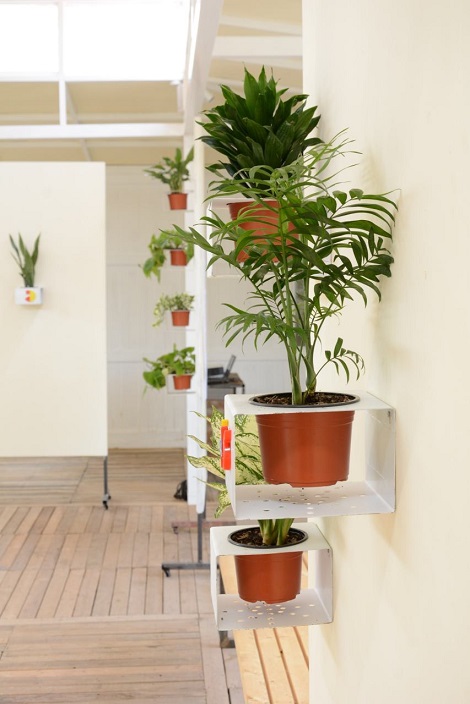
جاگلدانیها با توجه به تنوع کلاسها و کمبود فضا در برخی از مدارس، طراحی شدهاند. فرم جاگلدانیها تکرارپذیر(مدولار) هستند تا در درجهی اول نصب آن در تمامی فضاها و روی هر دیواری به آسانی امکانپذیر باشد و در درجهی دوم قابلیت تکثیر وجود داشته باشد؛ از یک گلدان تا دهها گلدان. فرم و متریال به گونهای طراحی شده تا قابلیت تعامل برای ثبت شرایط نگهداری گیاه توسط دانشآموزان و معلم را داشته باشد.
+ نتیجهی کار ایجاد دیوارهایی سبز در فضای داخلی مدرسههاست بنابراین برای پیشبرد این پروژه پس از تایید آن از جانب مدیریت مدرسه، طی جلسه و کارگاهی برای معرفی و نحوهی اجرای آن با دانشآموزانی که مایل به همکاری هستند تشکیل خواهیم داد. زمان آغاز و پایان هر دوره را سه ماهه در نظر گرفتهایم.
• از زمان شروع تا پایان حضور در این بخش از پروژه، تمامی مراحل توسط دانش آموزان داوطلب با عکاسی، فیلمبرداری و تهیهی پروندهای کتبی برای گیاهان ثبت خواهد شد. کتابچهای از روند این پروژه از شروع تا پایان آن به صورت دیجیتال یا افست منتشر خواهد شد. همچنین صفحه اینستاگرام برای به نمایش گذاشتن عکسها، نوشتهها و تجربهها و انتشار ویدیوهای آموزشی در ارتباط با پروژهی گوشههای سبز وجود خواهد داشت.
• این پروژه در نمایشگاه ها ، همایش ها همچنین برنامه های فرهنگی و هنری، مجلات و روزنامه ها قابل ارائه خواهد بود.
• با تشکر از انستیتو کاف، مدرسه الغدیر، مدرسه فرهنگ سعادت، مرسده صادقی, پانتهآ اسلامی ، هما دلورای، شهروز حکیمی، محمدرضا پورسیدی، علی صمدپور، علیرضا لبشکا، سیمین دهقانی، دکتر بمانیان، غزال همتی، محبوبه مداح، آبنوس البرزی،
نگار فرجیانی
بهمن١٣٩٦



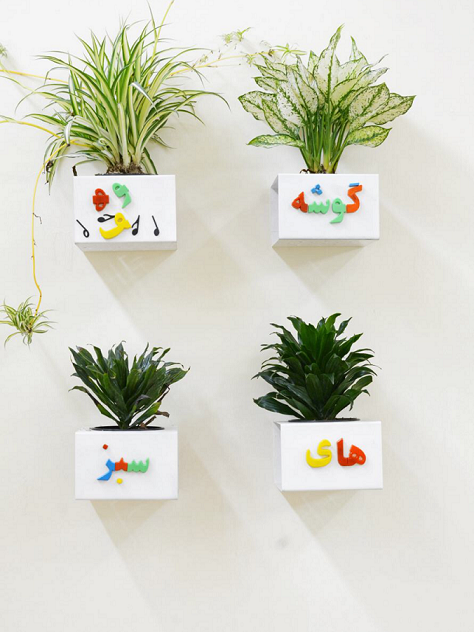
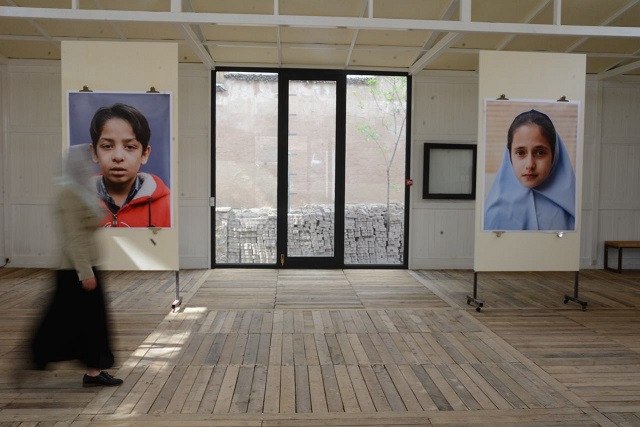

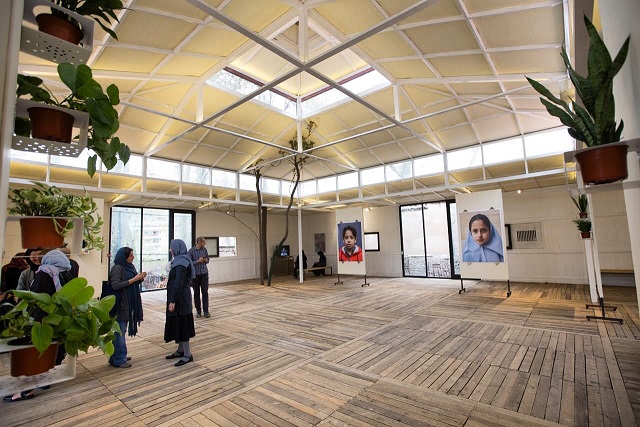
 Please wait...
Please wait...